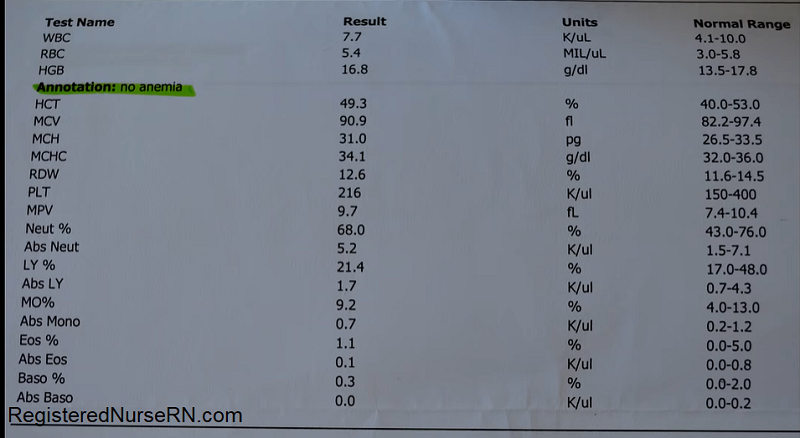Complete blood count (CBC) NCLEX review for nursing students!
As a nursing student or nurse you will want to be very familiar with the complete blood count. The complete blood count is also called a CBC for short.
Why is it so important to know about a CBC? This blood test is a very common test ordered on a patient in the hospital. Seriously, almost every patient that walks through the hospital doors will have a CBC. This is because it tells us about the overall health of the patient. For example, it can tell us if they have an infection, hemorrhage (blood loss), anemia, blood cancer etc.
For the NCLEX or nursing lecture exams, you want to know three things about the CBC:
- What the CBC assesses
- What each area represents that the CBC assesses
- Normal lab value ranges for each part of the CBC
Exam questions will majorly test you are the normal lab value ranges, and they will give you values that are noticeably abnormal…rather than close to normal. Therefore, if you have the approximate lab range memorized you will be able to recognize the abnormal range. NOTE: Normal lab value ranges vary among laboratories. For example, one lab may say a normal range is 12.5-20.5….while another one may say 10.5-22.5. Therefore, be aware of that when assessing results.
When you work as a nurse you will be able to see the patient’s lab result along with the normal lab ranges (see picture below).
The goal of this review is to help you know the main concepts about the CBC for exams and dive a little deeper into the other things you will see on a CBC report so you are familiar with it…like the RBC indices and WBC differential etc.
See more about labs to know for NCLEX.
How is a CBC collected?
It’s collected through a blood draw. Therefore, blood is removed from a vein and sent to the lab. The lab will analyze the results and send them back to you.
Example of CBC results:

WBC (White Blood Cells): 5,000–10,000
Main function of the WBC is to fight infection
Leukopenia: low WBC count
- Causes: autoimmune diseases, medications (immunosuppressive, mental health medications, chemo), severe illness sepsis, cancers, lupus, HIV/AID, radiation therapy
Leukocytosis: high WBC count
- Causes: infection, inflammation, leukemia, extreme stress, medication side effects etc.
- WBC w/ differential: looks at the 5 types of WBCs
- Monocytes (4-13%): fights infection and foreign substances
- Eosinophils (1-5%): plays a role in the allergic response and parasite infections
- Neutrophils (40-70%): fights bacterial infections
- Basophils (0.1-2%): plays a role in inflammatory conditions and allergy response
- Lymphocytes (20-40%): fights viral infections
RBC (Red Blood Cells): 4.5-5.5 million…also called erythrocytes or red blood corpuscles
Main function of the RBC is to transport oxygen throughout the body and deliver carbon dioxide to the lungs to be exhaled….helps detect anemia, hemorrhage etc.
Low red blood count is called anemia.
High red blood count is called polycythemia. (blood cancer…bone marrow making too many RBCs)
- Hemoglobin: protein on the RBC that helps carry oxygen in the body
- 12–16 g/dL (women)
- 14–18 g/dL (men)
- Hematocrit: amount of red blood cells compared to the total blood volume
- 37 – 47% (women)
- 42 – 52% (men)
- Red blood cell indices (indices is the plural form for index): This is a further look at the Red Blood Cell. It tells us the size of the RBCs and specifics about the hemoglobin, which is helpful with anemia (iron deficiency, vitamin b 12 or folate etc.).
- Mean Corpuscular Volume (MCV): size of the red blood cell (80-100 femtoliters…fl)
- Mean Corpuscular Hemoglobin (MCH): amount of hemoglobin in the red blood cell (27-33 picograms per cell…pg)
- Mean Corpuscular Hemoglobin Concentration (MCHC): concentration of hemoglobin in a RBC…(33-36 grams per deciliter)
- Red Cell Distribution Width (RDW)…(11-15%): measure the variation of red blood cell size.
PLT (Platelets): 150,000–400,000
Main function is to help with clotting when we’re bleeding
MPV: mean platelet volume (7-10 femtoliters…fl): average size of the platelets in the blood
Thrombocytopenia: low platelet count
- risk for bleeding out (causes: bone marrow issues, chemo, viral infection)
Thrombocytosis: high platelet count
- risk for clotting (causes leukemia, inflammation diseases, acute blood loss)
If results on the CBC are abnormal a peripheral smear may be ordered. This will look at the morphology (this means the form or the shape of the cell).
Now test your knowledge on the CBC with this Complete Blood Count NCLEX Questions quiz.
References: